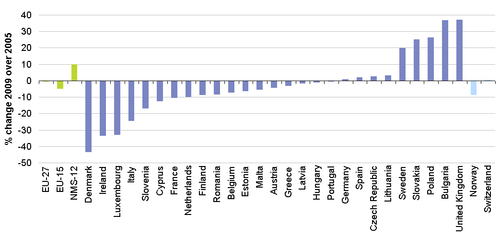Archive:Agricultural income per worker
- Data from March 2010, most recent data: Further Eurostat information, Main tables.
According to second estimates, real agricultural income per worker in the European Union has decreased by 16.6% in 2009, following a decrease by 1.8% in 2008. This decline results from a reduction in real agricultural income (-13.6%), together with a fall in agricultural labour input (-2.3%). These estimates for the EU are based on data supplied by the national authorities in the Member States.
Main statistical findings
Second estimates for 2010: down by 11,6% on the previous year
The decrease in EU real agricultural income in 2009 is mainly the result of a sharp fall in the value of agricultural output at producer prices in real terms (-10.5%), while input costs in real terms decreased (-9.2%). The small fall in the real value of subsidies net of taxes (-0.5%) and the slight decrease in depreciation in real terms (-0.2%) have a marginal impact.
Real agricultural income per worker in 2009 is estimated to have fallen in 21 Member States and to have risen in six. The largest falls are expected in Hungary (-32.2%), Luxembourg (-25.2%), Ireland (-23.6%), Germany (-21.0%), Italy (-20.6%), Austria (-19.4%) and France (-19.0%), and the highest rises in Malta (+7.8%), Denmark, (+4.3%) and Finland (+2.6%).
In 2009, the value of EU agricultural output at producer prices is estimated to have decreased by 10.7%, mainly due to a decrease in the value of both crop production (-13.0%) and animal production (-9.3%) in real terms.
- Declining crop prices: In crop production, the decrease in value is almost entirely due to a decline in prices (-12.8%), while the volume is expected to fall only slightly (-0.3%). Prices are falling for all groups of crops, except plants and flowers (+1.5%), most sharply for cereals (-27.1%), oilseeds (-24.8%), olive oil (-16.3%) and fruits (-15.9%). A rise in volume is seen for oilseeds (+10.8%), while olive oil (-9.3%) and cereals (-5.7%) are declining.
- Falling prices for animal production: The decrease in the value of animal production in 2009 is the result of a clear fall in producer prices (-8.3%) and a slight decline in volume (-1.0%). Prices are falling for the three largest animal products: milk (-20.6%), pigs (-3.8%) and cattle (-1.2%). The volume is nearly stable milk (-0.5%) unchanged for pigs and decreases for cattle (-3.0%).
- Decreasing input costs: EU agricultural input costs (intermediate consumption) are expected to fall by 9.2% in real terms, due to decreases in both volume (-2.7%) and prices (-6.7%). Lower input volumes are estimated for almost all categories of input, particularly for fertilizers (-14.6%). The fall in input prices is driven by sharp falls in feeding stuff (-16.7%) and energy (-14.5%).
Between 2005 and 2009, EU-27 real income per worker is estimated to have decreased by 0.3%. On average, agricultural labour input in the EU-27 has fallen by 11.5% since 2005.
Data sources and availability
Estimated results for agricultural income and labour input are submitted by Member States for the year in question by the end of November the same year and by the end of February the following year. Final data are submitted in September, 9 months after the end of the year.
Further Eurostat information
Publications
- Eurostat Newsrelease 66/2010, 7 May 2010 - Employment in the agriculture sector down by 25% between 2000 and 2009
- Statistics in focus 18/2010, 7 May 2010 - EU Agricultural Income down 11.6% in 2009
- Eurostat Newsrelease 186/2009, 18 December 2009 - EU27 real agricultural income per worker down by 12.2%
Main tables
- Agriculture (t_agri), see:
- Economic Accounts for Agriculture (t_aact)

